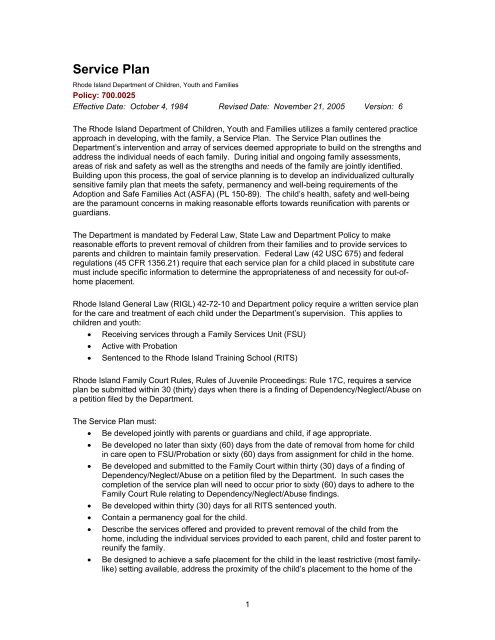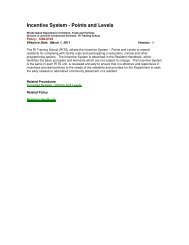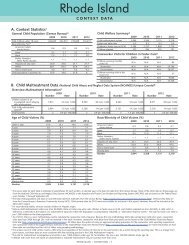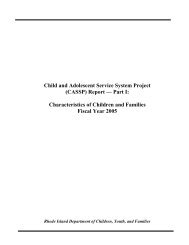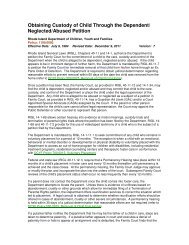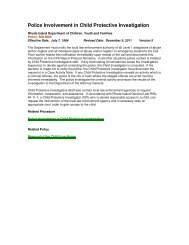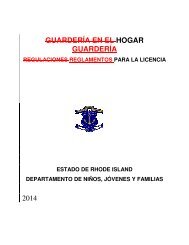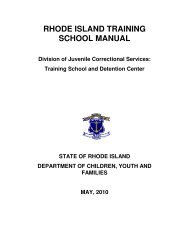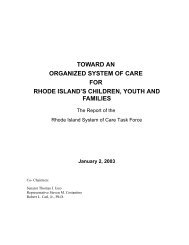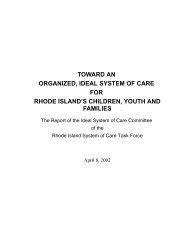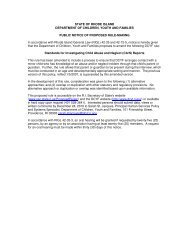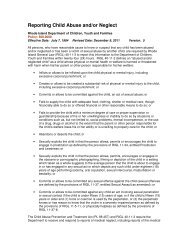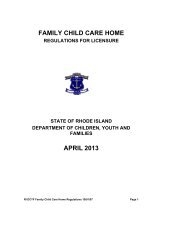Service Plan - RI Department of Children, Youth & Families
Service Plan - RI Department of Children, Youth & Families
Service Plan - RI Department of Children, Youth & Families
Create successful ePaper yourself
Turn your PDF publications into a flip-book with our unique Google optimized e-Paper software.
<strong>Service</strong> <strong>Plan</strong><br />
Rhode Island <strong>Department</strong> <strong>of</strong> <strong>Children</strong>, <strong>Youth</strong> and <strong>Families</strong><br />
Policy: 700.0025<br />
Effective Date: October 4, 1984 Revised Date: November 21, 2005 Version: 6<br />
The Rhode Island <strong>Department</strong> <strong>of</strong> <strong>Children</strong>, <strong>Youth</strong> and <strong>Families</strong> utilizes a family centered practice<br />
approach in developing, with the family, a <strong>Service</strong> <strong>Plan</strong>. The <strong>Service</strong> <strong>Plan</strong> outlines the<br />
<strong>Department</strong>’s intervention and array <strong>of</strong> services deemed appropriate to build on the strengths and<br />
address the individual needs <strong>of</strong> each family. During initial and ongoing family assessments,<br />
areas <strong>of</strong> risk and safety as well as the strengths and needs <strong>of</strong> the family are jointly identified.<br />
Building upon this process, the goal <strong>of</strong> service planning is to develop an individualized culturally<br />
sensitive family plan that meets the safety, permanency and well-being requirements <strong>of</strong> the<br />
Adoption and Safe <strong>Families</strong> Act (ASFA) (PL 150-89). The child’s health, safety and well-being<br />
are the paramount concerns in making reasonable efforts towards reunification with parents or<br />
guardians.<br />
The <strong>Department</strong> is mandated by Federal Law, State Law and <strong>Department</strong> Policy to make<br />
reasonable efforts to prevent removal <strong>of</strong> children from their families and to provide services to<br />
parents and children to maintain family preservation. Federal Law (42 USC 675) and federal<br />
regulations (45 CFR 1356.21) require that each service plan for a child placed in substitute care<br />
must include specific information to determine the appropriateness <strong>of</strong> and necessity for out-<strong>of</strong>home<br />
placement.<br />
Rhode Island General Law (<strong>RI</strong>GL) 42-72-10 and <strong>Department</strong> policy require a written service plan<br />
for the care and treatment <strong>of</strong> each child under the <strong>Department</strong>’s supervision. This applies to<br />
children and youth:<br />
• Receiving services through a Family <strong>Service</strong>s Unit (FSU)<br />
• Active with Probation<br />
• Sentenced to the Rhode Island Training School (<strong>RI</strong>TS)<br />
Rhode Island Family Court Rules, Rules <strong>of</strong> Juvenile Proceedings: Rule 17C, requires a service<br />
plan be submitted within 30 (thirty) days when there is a finding <strong>of</strong> Dependency/Neglect/Abuse on<br />
a petition filed by the <strong>Department</strong>.<br />
The <strong>Service</strong> <strong>Plan</strong> must:<br />
• Be developed jointly with parents or guardians and child, if age appropriate.<br />
• Be developed no later than sixty (60) days from the date <strong>of</strong> removal from home for child<br />
in care open to FSU/Probation or sixty (60) days from assignment for child in the home.<br />
• Be developed and submitted to the Family Court within thirty (30) days <strong>of</strong> a finding <strong>of</strong><br />
Dependency/Neglect/Abuse on a petition filed by the <strong>Department</strong>. In such cases the<br />
completion <strong>of</strong> the service plan will need to occur prior to sixty (60) days to adhere to the<br />
Family Court Rule relating to Dependency/Neglect/Abuse findings.<br />
• Be developed within thirty (30) days for all <strong>RI</strong>TS sentenced youth.<br />
• Contain a permanency goal for the child.<br />
• Describe the services <strong>of</strong>fered and provided to prevent removal <strong>of</strong> the child from the<br />
home, including the individual services provided to each parent, child and foster parent to<br />
reunify the family.<br />
• Be designed to achieve a safe placement for the child in the least restrictive (most familylike)<br />
setting available, address the proximity <strong>of</strong> the child’s placement to the home <strong>of</strong> the<br />
1
parents when the permanency goal is reunification and address how the placement is<br />
consistent with the best interests and special needs <strong>of</strong> the child.<br />
• Contain a visitation plan that is consistent with the specified permanency goal (refer to<br />
Policy 700.0040, Visitation).<br />
• Document the steps to finalize a placement when the permanency goal is or becomes<br />
adoption or another permanent placement option.<br />
• Include to the extent available and accessible updated health and education records <strong>of</strong><br />
the child (Federal Law also requires the <strong>Department</strong> to provide a copy <strong>of</strong> this information<br />
to the foster parent or foster care provider at the time <strong>of</strong> each placement).<br />
• Be formally reviewed by the Administrative Review Unit (ARU) no less frequently than<br />
every six (6) months for child or youth in out <strong>of</strong> home placement.<br />
• Be signed by all appropriate parties including age appropriate child (including any<br />
addenda added after the original signature).<br />
• Include for youth 16 and older a written description <strong>of</strong> the programs and services which<br />
will help the youth prepare for the transition from foster care to independent living.<br />
The DCYF <strong>Service</strong> <strong>Plan</strong> (DCYF #032) is time limited, individualized, strength-based and needs<br />
driven. The <strong>Service</strong> <strong>Plan</strong> clarifies how the parties will work together by identifying mutual<br />
responsibilities and expectations <strong>of</strong> each parent, child and the <strong>Department</strong> toward reaching the<br />
identified permanency goal. Staff must involve both the custodial and non-custodial parent in<br />
service planning and service provision. The <strong>Department</strong> is responsible to locate and engage<br />
absent parents in the service planning process.<br />
Full Disclosure begins, emphasizing the shortened time frames for reunification required by<br />
ASFA, as soon as a child is placed in substitute care and continues throughout the family’s<br />
involvement with the <strong>Department</strong>. Full Disclosure involves discussions with the birth family<br />
regarding their legal rights, responsibilities, permanency timeframes, permanency options,<br />
consequences and expectations <strong>of</strong> the <strong>Department</strong>. Concurrent <strong>Plan</strong>ning, which requires<br />
intensive work to achieve reunification while identifying a placement option for the child that will<br />
be permanent if reunification efforts are not successful, should be practiced when appropriate and<br />
reflected in the <strong>Service</strong> <strong>Plan</strong> (refer to Policy 700.0215, Concurrent <strong>Plan</strong>ning Policy).<br />
The <strong>Department</strong> has an appeals process for parents/guardians and children, to the extent <strong>of</strong> their<br />
ability to participate, who disagree with portions <strong>of</strong> the <strong>Service</strong> <strong>Plan</strong> and wish to appeal its<br />
implementation (refer to Policy 100.0055, Complaints and Hearings).<br />
Related Procedures<br />
<strong>Service</strong> <strong>Plan</strong><br />
Related Policy<br />
<strong>Service</strong> <strong>Plan</strong> Review<br />
Family Assessment<br />
2
<strong>Service</strong> <strong>Plan</strong><br />
Procedure From Policy 700.0025: <strong>Service</strong> <strong>Plan</strong><br />
A. Timeframes for completion, review and approval <strong>of</strong> the <strong>Service</strong> <strong>Plan</strong><br />
1. Family <strong>Service</strong>s and Probation<br />
a. The <strong>Service</strong> <strong>Plan</strong> (DCYF #032) is created in <strong>RI</strong>CHIST for each child or<br />
youth receiving services through a Family <strong>Service</strong>s or Probation Unit<br />
(refer to <strong>RI</strong>CHIST Window Help, <strong>Service</strong> <strong>Plan</strong> Doc).<br />
b. The initial <strong>Service</strong> <strong>Plan</strong> is completed by the assigned Family <strong>Service</strong>s<br />
Caseworker or Probation Officer within sixty (60) days <strong>of</strong> removal from<br />
the home or sixty (60) days <strong>of</strong> assignment to FSU/Probation.<br />
c. Each <strong>Service</strong> <strong>Plan</strong> is unique to the child or youth’s individual and family<br />
needs, including identification <strong>of</strong> individual and family strengths.<br />
d. Each <strong>Service</strong> <strong>Plan</strong> includes a visitation plan if the child is in care (refer to<br />
Policy 700.0040, Visitation Policy).<br />
e. In situations where the case is monitored by the Family Court, and there<br />
is an adjudication on a Dependency, Neglect and/or Abuse petition, the<br />
<strong>Service</strong> <strong>Plan</strong> is developed and submitted to the Court within thirty (30)<br />
days <strong>of</strong> the adjudication.<br />
f. Subsequent <strong>Service</strong> <strong>Plan</strong>s are completed by the assigned Family<br />
<strong>Service</strong> Caseworker/Probation Officer no less frequently than in six (6)<br />
month intervals. Revisions to the <strong>Service</strong> <strong>Plan</strong> may be necessary prior<br />
to the six (6) month interval:<br />
i. If the child with an initial <strong>Service</strong> <strong>Plan</strong> in FSU has other family<br />
members active in the Division, all <strong>Service</strong> <strong>Plan</strong>s subsequent to<br />
the initial one shall be completed in synchronization with the<br />
other family members.<br />
ii.<br />
If a substantive change in circumstances occurs or there is a<br />
change in the permanency goal, a new <strong>Service</strong> <strong>Plan</strong> must be<br />
developed within thirty (30) working days. In such circumstances<br />
the subsequent <strong>Service</strong> <strong>Plan</strong> shall be developed six (6) months<br />
from the time <strong>of</strong> the latest <strong>Service</strong> <strong>Plan</strong>.<br />
g. For a child active in FSU/Probation for whom a report <strong>of</strong> child abuse or<br />
neglect is subsequently indicated, the primary service worker is<br />
responsible for any needed changes in an existing <strong>Service</strong> <strong>Plan</strong> within<br />
thirty (30) days <strong>of</strong> the completed investigation.<br />
h. Any change in the <strong>Service</strong> <strong>Plan</strong> which does not alter the permanency<br />
goal for the child is entered as an Addendum to the DCYF #032.<br />
Changes must be acknowledged by the signature <strong>of</strong> all parties who<br />
originally signed the <strong>Service</strong> <strong>Plan</strong>.<br />
i. Once a <strong>Service</strong> <strong>Plan</strong> has been incorporated into a court order, any<br />
change in the plan shall be put before the court in the form <strong>of</strong> a motion<br />
filed in advance <strong>of</strong> the court date. This motion shall be filed in<br />
conjunction with DCYF legal staff and with notice provided to other<br />
involved parties.<br />
j. A copy <strong>of</strong> the <strong>Service</strong> <strong>Plan</strong> is submitted to the Court at each Permanency<br />
Hearing for children placed in foster care (refer to Policy 1100.0000,<br />
Obtaining Custody <strong>of</strong> Child through the Dependent/Neglect/Abuse<br />
Petition).<br />
k. The <strong>Department</strong> in compliance with Federal Law also has in place a<br />
family review system to review the <strong>Service</strong> <strong>Plan</strong> <strong>of</strong> each child in<br />
3
placement no less frequently than every six (6) months (refer to Policy<br />
700.0030, <strong>Service</strong> <strong>Plan</strong> Review).<br />
l. In cases where there is dual responsibility, the Probation Officer, FSU<br />
Caseworker or the respective supervisors discuss and mutually decide<br />
upon primary and secondary assignments in <strong>RI</strong>CHIST and mutual<br />
responsibilities in service planning (refer to Policy 800.0000, Transfer<br />
and Dual Supervision <strong>of</strong> <strong>Youth</strong> by Juvenile Probation and Family<br />
<strong>Service</strong>s).<br />
i. For youth active with FSU who are placed on Probation, the<br />
Probation Officer will include the Conditions <strong>of</strong> Probation (COP)<br />
and other appropriate objectives and tasks into the existing<br />
approved <strong>Service</strong> <strong>Plan</strong> in <strong>RI</strong>CHIST through an addendum.<br />
ii. For youth active with Probation who open for services in FSU,<br />
the FSU Caseworker will include appropriate objectives and<br />
tasks specific to the individual needs <strong>of</strong> the family into the<br />
existing approved <strong>Service</strong> <strong>Plan</strong> in <strong>RI</strong>CHIST through an<br />
addendum.<br />
iii. If there is not an existing approved <strong>Service</strong> <strong>Plan</strong>, the FSU<br />
Caseworker and Probation Officer will coordinate the<br />
development <strong>of</strong> the <strong>Service</strong> <strong>Plan</strong> and include appropriate<br />
objectives and tasks specific to the individual needs <strong>of</strong> the family<br />
into the unapproved <strong>Service</strong> <strong>Plan</strong> in <strong>RI</strong>CHIST.<br />
m. For youth transferring to FSU or Probation from the <strong>RI</strong>TS, the Discharge<br />
<strong>Plan</strong> that is created as part <strong>of</strong> the <strong>Service</strong> <strong>Plan</strong> remains active for sixty<br />
(60) days after the youth’s release, with the ability to amend prior to<br />
creating a new <strong>Service</strong> <strong>Plan</strong> (refer to Policy 1200.1620, Transfer <strong>of</strong><br />
<strong>Youth</strong> to/from the Rhode Island Training School, <strong>RI</strong>TS).<br />
n. Completed <strong>Service</strong> <strong>Plan</strong> is sent to the primary worker’s supervisor for<br />
approval.<br />
i. All sections <strong>of</strong> the <strong>Service</strong> <strong>Plan</strong> must be completed prior to<br />
sending the document for approval, including the visitation plan<br />
and identification <strong>of</strong> family strengths.<br />
ii. For dual supervision cases, the worker with primary assignment<br />
is responsible to send the <strong>Service</strong> <strong>Plan</strong> to his or her supervisor<br />
for approval.<br />
iii. If the FSU Caseworker, <strong>RI</strong>TS Clinical Social Worker and/or<br />
Probation Officer do not agree about sections <strong>of</strong> the <strong>Service</strong> <strong>Plan</strong><br />
and are unable to resolve differences, the matter will be referred<br />
to the next level in the chain <strong>of</strong> command.<br />
2. The Rhode Island Training School<br />
a. The <strong>Service</strong> <strong>Plan</strong> (DCYF #032) is created in <strong>RI</strong>CHIST for a youth<br />
sentenced to the <strong>RI</strong> Training School unique to his or her individual and<br />
family needs, including identification <strong>of</strong> individual and family strengths<br />
and a visitation plan if appropriate (refer to <strong>RI</strong>CHIST Window Help,<br />
<strong>Service</strong> <strong>Plan</strong> Doc).<br />
b. The initial <strong>Service</strong> <strong>Plan</strong> is completed by the assigned <strong>RI</strong>TS Clinical<br />
Social Worker thirty (30) days following adjudication.<br />
c. The Coordinator <strong>of</strong> Clinical <strong>Service</strong>s, or appropriate designee, will<br />
schedule a <strong>Service</strong> <strong>Plan</strong> meeting within seven (7) days and the meeting<br />
will occur within thirty (30) days <strong>of</strong> the youth’s sentencing.<br />
i. If there is dual supervision, the appropriate FSU<br />
Caseworker/Probation Officer will be notified <strong>of</strong> the meeting and<br />
will make every effort to attend.<br />
4
ii. Also invited to the meeting will be the youth's parents, unit<br />
manager, clinical social worker, clinical director or designee,<br />
medical/clinical representative and <strong>RI</strong> Training School Education<br />
Program representative.<br />
iii. An individualized <strong>Service</strong> <strong>Plan</strong> outlining academic and/or<br />
vocational programs and various treatment programs shall be<br />
developed at the <strong>Service</strong> <strong>Plan</strong> meeting.<br />
iv. The development <strong>of</strong> the <strong>Service</strong> <strong>Plan</strong> and the IEP shall be<br />
coordinated, when appropriate, to provide a comprehensive<br />
integrated plan (refer to Policy 1200.1732, The Individualized<br />
Education Program (IEP) Policy).<br />
d. The <strong>Service</strong> <strong>Plan</strong> shall be reviewed and revised, if appropriate, at the bimonthly<br />
review meeting.<br />
e. Sixty (60) days prior to a youth’s discharge from the <strong>RI</strong>TS, a<br />
transition/discharge planning meeting takes place to identify clinical and<br />
medical needs, as well as to identify an appropriate permanency goal for<br />
the youth.<br />
f. The clinical social worker is responsible for creating and maintaining the<br />
<strong>Service</strong> <strong>Plan</strong> for the resident in <strong>RI</strong>CHIST.<br />
g. The <strong>RI</strong> Training School Education Program representative is responsible<br />
for entering educational information for the resident in <strong>RI</strong>CHIST.<br />
h. The unit manager is responsible for overseeing the implementation <strong>of</strong> the<br />
resident’s <strong>Service</strong> <strong>Plan</strong> and for bringing it to the attention <strong>of</strong> appropriate<br />
staff.<br />
i. In cases where there is dual responsibility, the Probation Officer, <strong>RI</strong>TS<br />
Clinical Social Worker, FSU Caseworker or the respective supervisors<br />
discuss and mutually decide upon primary and secondary assignments<br />
in <strong>RI</strong>CHIST and mutual responsibilities in service planning.<br />
i. For youth sentenced to the <strong>RI</strong>TS who transfer from Family<br />
<strong>Service</strong>s or Probation, the <strong>RI</strong>TS Clinical Social Worker will<br />
include appropriate objectives and tasks specific to the youth’s<br />
sentence into the existing approved <strong>Service</strong> <strong>Plan</strong> in <strong>RI</strong>CHIST<br />
through an addendum.<br />
ii. For youth sentenced without prior DCYF involvement, the <strong>RI</strong>TS<br />
Clinical Social Worker will create a <strong>Service</strong> <strong>Plan</strong> in <strong>RI</strong>CHIST.<br />
j. Completed <strong>Service</strong> <strong>Plan</strong>s are sent to the primary worker’s supervisor for<br />
approval.<br />
i. All sections <strong>of</strong> the <strong>Service</strong> <strong>Plan</strong> must be completed prior to<br />
sending the document for approval, including the visitation<br />
agreement and identification <strong>of</strong> family strengths.<br />
ii. For dual supervision cases, the worker with primary assignment<br />
is responsible to send the <strong>Service</strong> <strong>Plan</strong> to his or her supervisor<br />
for approval.<br />
iii. If the <strong>RI</strong>TS Clinical Social Worker, FSU Caseworker and/or<br />
Probation Officer do not agree about sections <strong>of</strong> the <strong>Service</strong> <strong>Plan</strong><br />
and are unable to resolve differences, the matter will be referred<br />
to the next level in the chain <strong>of</strong> command.<br />
B. Development <strong>of</strong> the <strong>Service</strong> <strong>Plan</strong><br />
1. A <strong>Service</strong> <strong>Plan</strong> must be developed jointly with the child, if age appropriate,<br />
parents or guardians.<br />
5
a. This capacity will vary among children; however, most school-aged<br />
children can be expected to participate to some extent if they are verbal<br />
and understand most <strong>of</strong> the events occurring in their lives.<br />
b. Workers will consult with the child (as age appropriate) on the child's<br />
goals and services, review the plan with the child before finalizing it to<br />
ensure the child's input, explain the plan and terms used in the plan in<br />
language that the child can understand and include the child (as age<br />
appropriate) in periodic service planning meetings.<br />
2. The <strong>Service</strong> <strong>Plan</strong> reflects the principles <strong>of</strong> family centered practice and identifies<br />
how the family will mobilize their strengths and resources to address concerns in<br />
a way that ensures safety, well-being and supports permanency for the child.<br />
3. The DCYF worker encourages full participation <strong>of</strong> the child’s custodial and noncustodial<br />
parents, other extended family and service providers to the extent<br />
permissible in service planning, including the completion <strong>of</strong> a strength based<br />
family assessment.<br />
a. The <strong>Department</strong> is responsible to locate and engage absent parents and<br />
document efforts in the <strong>Service</strong> <strong>Plan</strong>.<br />
b. If a putative father notifies the <strong>Department</strong> that he may be the father <strong>of</strong> a<br />
child in care, steps must be taken to determine paternity. Once paternity<br />
is established, the father is included in the service planning process.<br />
4. Family <strong>Service</strong> Caseworker and Probation Officer coordinate a meeting with<br />
family members and service providers at the beginning <strong>of</strong> the case to capture<br />
comprehensive information about the family and to develop the <strong>Service</strong> <strong>Plan</strong>.<br />
a. The meeting can be scheduled at a DCYF <strong>of</strong>fice, in the family’s home, at<br />
a community provider’s <strong>of</strong>fice or at a location appropriate to meet the<br />
needs <strong>of</strong> the family.<br />
b. For a child placed in a group home or treatment facility, DCYF service<br />
planning should be coordinated with the child’s treatment plan.<br />
c. Documentation <strong>of</strong> the meeting is recorded in a Case Activity Note (CAN).<br />
d. In the event the family is unwilling to participate in the service planning<br />
process and/or worker is unable to schedule a meeting with family<br />
members and service providers, worker must document in a CAN efforts<br />
to engage the family.<br />
5. For youth sentenced to the <strong>RI</strong>TS, the <strong>Service</strong> <strong>Plan</strong> is developed with input from<br />
the youth, family, clinical social worker, unit manager, education program<br />
representative and health coordinator during the <strong>Service</strong> <strong>Plan</strong> Meeting.<br />
C. Content <strong>of</strong> the <strong>Service</strong> <strong>Plan</strong><br />
1. Each <strong>Service</strong> <strong>Plan</strong> must include a permanency goal specific to the family’s<br />
situation.<br />
2. The projected date for achieving the identified permanency goal must be<br />
indicated in the <strong>Service</strong> <strong>Plan</strong>.<br />
3. The DCYF worker consults with his or her supervisor to determine which<br />
permanency goal is appropriate to meet the needs <strong>of</strong> the child and family. The<br />
goals are:<br />
a. Maintenance at home<br />
i. For a child remaining at home, the permanency goal is<br />
maintenance <strong>of</strong> the child at home.<br />
ii.<br />
iii.<br />
The child’s safety must be assured.<br />
In home family services or family preservation shall be<br />
considered as options to prevent out-<strong>of</strong>-home placement <strong>of</strong> the<br />
child.<br />
6
iv. The <strong>Service</strong> <strong>Plan</strong> must describe the services <strong>of</strong>fered and<br />
provided to prevent removal <strong>of</strong> the child from the home including<br />
the individual services provided to each parent and child.<br />
v. When this goal is selected, worker confirms in <strong>RI</strong>CHIST that "if<br />
preventive services arranged by DCYF are unsuccessful, this<br />
child may be placed in substitute care."<br />
b. Reunification<br />
i. For a child in placement, the initial permanency goal is<br />
reunification in nearly all situations with specific exceptions as<br />
approved by the Family Court.<br />
ii. Family reunification is the planned process <strong>of</strong> reconnecting<br />
children in out-<strong>of</strong>-home care with their families by means <strong>of</strong> a<br />
variety <strong>of</strong> services and supports to the children, their families,<br />
and their foster parents or other service providers.<br />
iii. <strong>Service</strong> planning is directed toward addressing those concerns<br />
which led to the child being removed from his or her home.<br />
iv. The <strong>Department</strong> will assess and refer the family to the<br />
appropriate array <strong>of</strong> services to achieve reunification in the<br />
shortest time possible with consideration for the child's safety<br />
and well-being.<br />
v. The <strong>Service</strong> <strong>Plan</strong> must be designed to achieve a safe placement<br />
for the child in the least restrictive (most family-like) setting<br />
available, discuss the proximity <strong>of</strong> the child’s placement to the<br />
home <strong>of</strong> the parents and discuss how the placement is<br />
consistent with the best interests and special needs <strong>of</strong> the child.<br />
vi. For youth sentenced to the <strong>RI</strong>TS, the initial permanency goal is<br />
generally reunification. For youth transferring from FSU or<br />
Probation, the goal then reflects prior history. At the time <strong>of</strong> the<br />
discharge/transition meeting, an appropriate permanency goal<br />
will be identified after a review <strong>of</strong> the youth’s individual/family<br />
needs.<br />
c. Adoption<br />
i. When reunification is not viable, adoption by relatives, foster<br />
parents or a licensed adoptive resource is the preferred<br />
permanency goal.<br />
ii. The <strong>Service</strong> <strong>Plan</strong> must document the steps to finalize a<br />
placement when the permanency goal is or becomes adoption.<br />
d. Guardianship<br />
i. If the court has determined that reunification and adoption are<br />
not viable permanency options, legal guardianship provides the<br />
child with the next preferable goal.<br />
ii. Legal guardianship enables the caretaker to exercise all the legal<br />
rights and responsibilities <strong>of</strong> a parent without the on-going<br />
oversight <strong>of</strong> DCYF.<br />
iii. Guardianship may be an option for youth with or without the<br />
termination <strong>of</strong> parental rights.<br />
e. Permanent placement with a fit and willing relative<br />
i. ASFA indicates that a "fit and willing relative" can provide a<br />
"planned permanent living arrangement" and that termination <strong>of</strong><br />
parental rights does not have to occur within the allotted time<br />
frame if a compelling reason is provided to the Court.<br />
ii. A relative may be able and willing to care for the child but is not<br />
prepared to consider legal guardianship or adoption.<br />
7
iii.<br />
iv.<br />
When determining if this permanency goal is appropriate, worker<br />
must consider the relationship between the child and parent(s),<br />
the relationship between the child and the relative(s) and the<br />
relationship between the relative(s) and the child’s parent(s). A<br />
compelling reason is documented, and provided to the Court<br />
addressing the established relationships and why adoption or<br />
guardianship are not viable permanency options.<br />
This permanency option is captured in the <strong>Service</strong> <strong>Plan</strong> under<br />
Permanent Placement with Relative.<br />
f. <strong>Plan</strong>ned Living Arrangement /Independent living (when appropriate for<br />
youth over age 16) and <strong>Plan</strong>ned Living Arrangement/Other<br />
i. A planned living arrangement is a permanent placement for the<br />
child that identifies a lifelong connection.<br />
ii.<br />
The <strong>Service</strong> <strong>Plan</strong> must specify who will be the permanent<br />
connection for that youth, if identified, and how DCYF is working<br />
to maintain that connection.<br />
iii. The permanency goal <strong>of</strong> <strong>Plan</strong>ned Living Arrangement/<br />
Independent Living or <strong>Plan</strong>ned Living Arrangement/Other, is<br />
appropriate only when documentation has been provided to the<br />
court that compelling reasons exist which make all other<br />
permanency options unacceptable. These reasons shall be reexamined<br />
at each ARU and every permanency hearing to<br />
access whether a more preferred permanency option is possible.<br />
4. To successfully achieve any permanency goal, specific objectives and tasks<br />
must be identified at the outset. Due to the shortened time frames for<br />
reunification required by ASFA, it is essential that the DCYF worker immediately<br />
clarify with the family each objective and task necessary to achieve the<br />
permanency goal. It is equally important to clarify what is not negotiable about<br />
the <strong>Service</strong> <strong>Plan</strong> and consequences for not meeting the time frames.<br />
a. Objectives are focused around the immediate area <strong>of</strong> risk, are<br />
achievable, measurable and time limited.<br />
i. The child’s needs, which may change over time, are the constant<br />
frame <strong>of</strong> reference during planning and implementation.<br />
ii. Objectives will be identified through the completion <strong>of</strong> ongoing<br />
strength based assessments <strong>of</strong> the family (refer to Policy<br />
700.0075, Family Assessment).<br />
iii. The initial <strong>Service</strong> <strong>Plan</strong> and all subsequent <strong>Service</strong> <strong>Plan</strong>s must<br />
clearly spell out every objective determined to be necessary to<br />
achieve the agreed upon permanency goal.<br />
iv. All unmet objectives are included in subsequent <strong>Service</strong> <strong>Plan</strong>s<br />
as well as met objectives to track progress in meeting the<br />
permanency goal.<br />
v. Objectives are aimed at correcting or significantly alleviating<br />
areas <strong>of</strong> risk that are directly related to the child’s safety and<br />
well-being.<br />
b. Each objective is comprised <strong>of</strong> individual tasks which, if successfully<br />
completed, will achieve the objective.<br />
i. Tasks in the <strong>Service</strong> <strong>Plan</strong> are individualized, culturally sensitive<br />
and designed to enhance a family’s strengths to address the<br />
safety/risk concerns identified through the completion <strong>of</strong> ongoing<br />
strength based assessments <strong>of</strong> the family.<br />
ii. Tasks are identified for specific individuals to be completed<br />
within a specified time frame.<br />
8
iii. Tasks are written in straightforward language so that each party<br />
clearly understands what is expected <strong>of</strong> him/her.<br />
iv. Tasks are developed for each identified objective.<br />
v. Tasks are reviewed with individuals routinely, acknowledging<br />
success and encouraging completion when appropriate.<br />
5. Section 475 (1)(D) <strong>of</strong> the Social Security Act states that where appropriate, for a<br />
child age sixteen (16) or older, a written description <strong>of</strong> the programs and services<br />
which will help such child prepare for the transition from foster care to<br />
independent living must be included in their <strong>Service</strong> <strong>Plan</strong>.<br />
a. This does not mean that reunification efforts should cease or that the<br />
goal <strong>of</strong> the <strong>Service</strong> <strong>Plan</strong> must change to <strong>Plan</strong>ned Living<br />
Arrangement/Independent Living.<br />
b. The <strong>Department</strong> has established a program to assess independent living<br />
skills and assist youth with the transition to adulthood (refer to Policy<br />
700.0200, Independent Living). Documentation <strong>of</strong> a youth’s participation<br />
in any <strong>of</strong> the programs <strong>of</strong>fered to assess independent living skills is<br />
captured in the <strong>Service</strong> <strong>Plan</strong>.<br />
6. Worker must involve children and parents or other primary caregivers in all<br />
aspects <strong>of</strong> planning and implementation whenever possible.<br />
a. Obtaining signatures on the <strong>Service</strong> <strong>Plan</strong> confirms that all parties<br />
participated in the development, review and revision <strong>of</strong> the plan and were<br />
provided the opportunity to agree or disagree with the content.<br />
b. Each party signing the <strong>Service</strong> <strong>Plan</strong> has the right to disagree with the<br />
content <strong>of</strong> the plan and appeal implementation <strong>of</strong> the plan (refer to<br />
section E, Appeal <strong>of</strong> the <strong>Service</strong> <strong>Plan</strong>).<br />
c. The following individuals sign the <strong>Service</strong> <strong>Plan</strong>:<br />
i. Parents/guardians<br />
ii. <strong>Children</strong> twelve (12) years <strong>of</strong> age or older (with capacity to<br />
participate)<br />
iii. DCYF primary service workers: FSU Caseworkers/Probation<br />
Officers/<strong>RI</strong>TS Clinical Social Workers<br />
iv. Foster parents or provider agency representatives who are<br />
involved in the development <strong>of</strong> the <strong>Service</strong> <strong>Plan</strong> and are directly<br />
responsible to provide the services prescribed in the <strong>Service</strong><br />
<strong>Plan</strong><br />
v. <strong>Department</strong> staff person, other than the primary service worker,<br />
who is involved with the family<br />
vi. Pre-adoptive parents in cases where parental rights have been<br />
terminated and the child is in a pre-adoptive home where the<br />
foster parents have initiated the adoption process<br />
c. The supervisor signs only after all other signatures are obtained or a<br />
reason is given for not signing.<br />
d. Once the <strong>Service</strong> <strong>Plan</strong> has been signed, any new objective and task<br />
agreed to at a later time is added to the <strong>Service</strong> <strong>Plan</strong> in the form <strong>of</strong> an<br />
addendum and signed by all appropriate parties.<br />
D. Distribution <strong>of</strong> the <strong>Service</strong> <strong>Plan</strong><br />
1. The primary service worker must use discretion to maintain the family’s right to<br />
privacy. A signed Authorization to Obtain or Release Confidential Information<br />
(DCYF #007) must be obtained when appropriate (refer to Policy 100.0000,<br />
Confidentiality).<br />
9
2. The original <strong>Service</strong> <strong>Plan</strong> is filed in the case record. A copy is given to the<br />
parents, and copies are provided to children, if age appropriate, and to each<br />
outside agency involved in the development <strong>of</strong> the <strong>Service</strong> <strong>Plan</strong> and directly<br />
responsible to provide services prescribed in the <strong>Service</strong> <strong>Plan</strong>.<br />
3. The <strong>Service</strong> <strong>Plan</strong> includes the Educational/Medical Statement (DCYF #132)<br />
which contains federally required health and education information that must be<br />
provided to the foster care provider when a child enters placement. DCYF form<br />
#132 is updated and provided to the foster parent or foster care provider at the<br />
time <strong>of</strong> each placement. Information required on each child to the extent<br />
available and accessible is as follows:<br />
a. Name and address <strong>of</strong> health and educational providers;<br />
b. Grade level performance;<br />
c. School record;<br />
d. Assurances that the child’s placement in foster care takes into account<br />
proximity to the school in which the child is enrolled at the time <strong>of</strong><br />
placement;<br />
e. Record <strong>of</strong> immunizations;<br />
f. Known medical problems;<br />
g. Medication; and,<br />
h. Any other relevant health and education information concerning the child<br />
determined to be appropriate by the agency.<br />
4. The DCYF #132 is provided to the foster parents separate from the <strong>Service</strong> <strong>Plan</strong><br />
if it is not appropriate for the caretakers to receive the entire <strong>Service</strong> <strong>Plan</strong>.<br />
5. Copies <strong>of</strong> the <strong>Service</strong> <strong>Plan</strong> are periodically provided to the Family Court in<br />
situations where there is Court involvement with the family.<br />
a. Within thirty (30) days <strong>of</strong> adjudication on a Dependency/Neglect/Abuse<br />
petition;<br />
b. No less frequently than on an annual basis at the time <strong>of</strong> the<br />
Permanency Hearing, and;<br />
c. At the time <strong>of</strong> the Family Court review <strong>of</strong> voluntary placements<br />
6. A copy <strong>of</strong> the <strong>Service</strong> <strong>Plan</strong> is given to the CASA.<br />
7. The current <strong>Service</strong> <strong>Plan</strong> is available to the Administrative Review Unit in<br />
<strong>RI</strong>CHIST for review prior to the scheduled date <strong>of</strong> the Administrative Review.<br />
E. Appeal <strong>of</strong> the <strong>Service</strong> <strong>Plan</strong><br />
1. Family <strong>Service</strong> Caseworker, Probation Officer or <strong>RI</strong>TS Clinical Social Worker<br />
explains the <strong>Department</strong>'s appeal procedure (refer to Policy 1000.0055,<br />
Complaints and Hearings) to the parents and child, to the extent <strong>of</strong> his/her ability<br />
to understand, at each signing <strong>of</strong> the <strong>Service</strong> <strong>Plan</strong> (DCYF #032).<br />
2. Worker provides each parent and child (if <strong>of</strong> appropriate age) with a Notification<br />
<strong>of</strong> Right to Appeal (DCYF #082) and provides a copy <strong>of</strong> the complete procedure<br />
upon request.<br />
3. Worker assists each parent and child to participate in the appeal process by<br />
providing at a minimum a copy <strong>of</strong> the DCYF form # 016, Formal Request for<br />
Hearing, instructions for completing the form, and guidance as to how to process<br />
the appeal through the various stages.<br />
10


